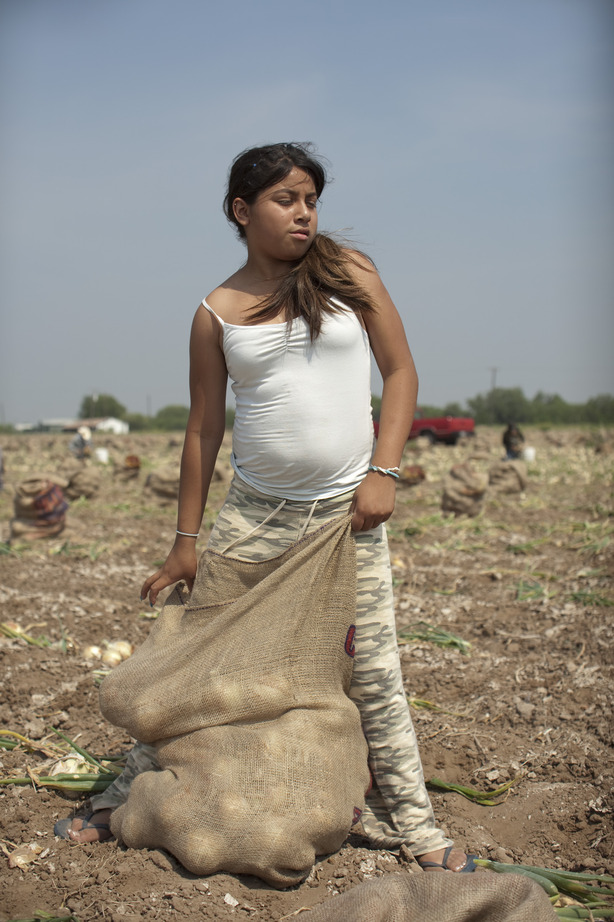MAR 26 2012
Do Children Harvest Your Food?
The Harvest, U Roberto Romano’s poignant film, forces us to think about where our food is coming from. Today, nearly 500,000 children as young as six harvest 25 percent of our crops.
BY HELENE YORK
Knowing the farmer who grows your food has become an important tenet of the modern food movement, but precious little attention is paid to the people who actually pick the crops or “process” the chickens or fillet the fish. U Roberto Romano’s poignant film, The Harvest/La Cosecha (2011), being screened across the country for Farmworker Awareness Week (March 24-29), informs us that nearly 500,000 children as young as six harvest up to 25 percent of all crops in the United States.
What’s illegal in most countries is permitted here. Child migrant labor has been documented in the 48 contiguous states. Seasonal work originates in the southernmost states in late winter where it is warm and migrates north as the weather changes. Every few weeks as families move, children leave school and friends behind. If you’ve had onions (Texas), cucumbers (Ohio or Michigan), peppers (Tennessee), grapes (California), mushrooms (Pennsylvania), beets (Minnesota), or cherries (Washington), you’ve probably eaten food harvested by children.
This isn’t a slavery issue, or an immigration issue per se. What’s remarkable is that most of the migrant child farmworkers are American citizens trying to help their families. This is a poverty issue and it gets to the heart of what we, as consumers, see as the “right price” to pay for food.
Americans pay a fantastically low percentage of our income on food—less than in any other developed country.
Edward R. Murrow’s brilliant documentary about the exploitation of farm workers, Harvest of Shame, was a revelation to TV viewers in 1960. Unfortunately, in 2012, little has changed in the fields. There are no minimum-wage requirements, overtime payments, or guaranteed days off. Farm wages are stagnant. As a result, many farm workers can’t afford to eat the food they pick. (In his book Tomatoland, Barry Estabrook reported that the food pantry is busy every night in Immokalee, Florida, the winter tomato-picking epicenter.)
Children earn about $1,000 per year for working an average of 30 hours a week, according to the U.S. Department of Labor. When you consider that the average annual pay for a migrant family of four is $12,500-$14,500, it’s apparent why some families feel they have no choice but to bring their children into the fields with them. Half of these kids will not graduate from high school because they’re always moving around, perpetuating the cycle of poverty that caused them to be day laborers in the first place.
And despite an idyllic “back to the land” reputation, crop fields are not the safest work environments for anyone. They’re stiflingly hot at times and are often sprayed with toxic pesticides that cause skin irritations, nausea, and breathing difficulties. Because of their size and stage of development, children are up to three times more vulnerable (PDF) to pesticide exposure than adults.
I first met Romano at TEDxFruitvale, the 2011 conference that Bon Appetit sponsored, which examined farm-labor problems; we talked again two weeks ago. He’s a tireless advocate for children’s rights and argues for enactment of the Federal Children’s Act for Responsible Employment (CARE) Act, which would require that children be a minimum of 14 years old to work in the fields (exempting family farms). It would also increase penalties for child labor violations and strengthen provisions for pesticide exposure.
In 1938, Federal law extended protections to working children — but it intentionally excluded agriculture. Romano points out the irony that a 13-year-old child is permitted to work in 100-degree heat in a strawberry field but not in an air-conditioned office. This exclusion may have had real validity when most food came from family farms. Today, when family farms produce less than 1.5 percent of the food we eat, it demands reconsideration.
As important as legal rights are, protective legislation may not be the best approach. Migrant families will lose their children’s wages and would be unable to move with available work.
What’s needed is more income paid to laborers for the really hard work. And that’s a hard victory to achieve. It has taken the Coalition of Immokalee Workers’ Campaign for Fair Food almost 20 years to achieve modest victories in persuading larger commercial purchasers to pay a penny per pound more for Florida tomatoes, and not all have agreed. (One cent equals a pay raise of 40 percent.) It’s a huge start. Despite growers’ complaints of foreign competition undercutting their sales, there’s no evidence that one penny makes a difference to anyone — except, of course, the harvesters.
Americans pay a fantastically low percentage of our income on food — less than in any other country in the developed world and less than we did in 1960. Our very cheap food comes with enormous environmental, social, and public health costs. It’s time to end child field labor by paying adult laborers a wage that is truly decent.
>via: http://www.theatlantic.com/health/archive/2012/03/do-children-harvest-your-food/254853/


